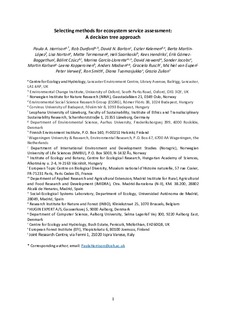Selecting methods for ecosystem service assessment: A decision tree approach
Harrison, Paula A.; Dunford, Robert; Barton, David Nicholas; Kelemen, Eszter; Martín-López, Berta; Norton, Lisa; Termansen, Mette; Saarikoski, Heli; Hendriks, Kees; Gomez-Baggethun, Erik; Czúcz, Balint; García-Llorente, Marina; Howard, David; Jacobs, Sander; Karlsen, Martin; Kopperoinen, Leena; Madsen, Andes; Rusch, Graciela; van Eupen, Michiel; Verweij, Peter; Smith, Ron; Tuomasjukka, Diana; Zulian, Grazia
Journal article, Peer reviewed
Accepted version

Åpne
Permanent lenke
http://hdl.handle.net/11250/2465812Utgivelsesdato
2017Metadata
Vis full innførselSamlinger
- Publikasjoner fra CRIStin - NINA [2364]
- Scientific publications [1392]
Originalversjon
10.1016/j.ecoser.2017.09.016Sammendrag
A range of methods are available for assessing ecosystem services. Methods differ in their aims; from mapping and modelling the supply and demand of ecosystem services to appraising their economic and non-economic importance through valuation techniques. Comprehensive guidance for the selection of appropriate ecosystem service assessment methods that addresse the requirements of different decision-making contexts is lacking. This paper tackles this gap using the experience from 27 case studies which applied different biophysical, socio-cultural and monetary valuation methods to operationalise the ecosystem service concept towards sustainable land, water and urban management. A survey of the reasons why the case study teams selected particular methods revealed that stakeholder-oriented reasons, such as stakeholder participation, inclusion of local knowledge and ease of communication, and decision-oriented reasons, such as the purpose of the case study and the ecosystem services at stake, were key considerations in selecting a method. Pragmatic reasons such as available data, resources and expertise were also important factors. This information was used to develop a set of linked decision trees, which aim to provide guidance to researchers and practitioners in choosing ecosystem service assessment methods that are suitable for their context.
